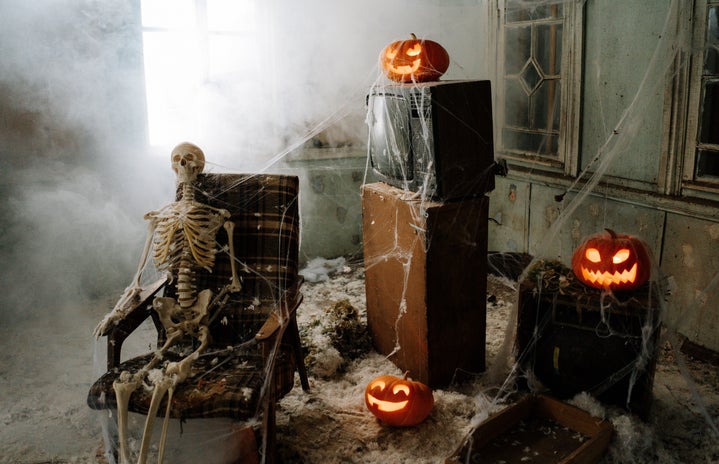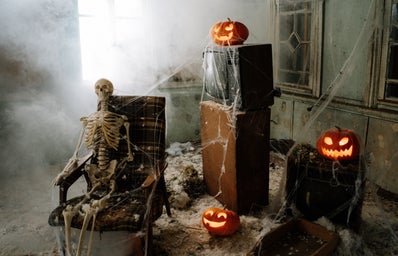If you’re like me, who’s crazy about vampires, you’ve probably come across the mysterious and oftentimes creepy (or hot), Count Dracula. Though, haven’t you ever wondered where this famous monster comes from? What’s his origin story? Well, I had those same questions when I was searching for Halloween lore. So, for this spooky season, I wanted to investigate this notorious vampire along with other pop culture monsters. Heads up: turns out that most of them are from fiction, legends, or myths! So, let’s dive into the origins of popular Halloween creatures like Frankenstein, zombies, and, drum roll please… vampires!
Frankenstein: let’s just say he has a few loose screws
Most people associate the green skinned (or pale) monster with screws and stitches as Frankenstein. However, his name is actually a common misconception. See, in 1819, Mary Shelley, an English writer, created Frankenstein (pun intended). Her novel tells the tale of a scientist named Victor Frankenstein who created a being that he called the “monster.” So really the name of this creature is simply just “monster” (because he technically never got a name). Which means that the man behind his existence, the scientist, is the real Frankenstein. But, why do so many people get it wrong, even to this day? Shelley’s story has had varied film adaptations. Due to these Hollywood movies and the media, these diverse interpretations have been considered factual by many who have likely never read, or even known, about the original work by Mary Shelley. I’ve read Frankenstein and the movies don’t live up to the original when it comes to the message it portrays. I highly recommend that you read this outstanding classic!
Zombies: are they dead serious?
For this one, I had to dig a little deeper (pun intended). You might be familiar with the usual depiction of these undead monsters: rotting, slow corpses suspended in animation. Unfortunately though, the origin of the zombie character has a tragic and very sad past. During the 18th & 19th century when Haiti was still a French colony, Haitians worked as slaves for sugar plantations. The caribbean people suffered for decades, often opting for suicide as their only way to be free from their master’s oppression. But the Haitian people feared that, if they turned into zombies, they would never reach their own heaven in Africa, their homeland. Those who partook in the Voodoo religion believed that, when they died, Baron Samedi (an iwa in Voodoo), would help the dead cross over to the other side. He would be our Western-influenced version of the Grim Reaper. However, if Baron was offended by the dead person in some way, he wouldn’t let them cross over, and therefore that person would be zombified. This person would then be forced to serve their master for eternity, and so this fear of becoming zombies led the Haitian people to avoid death. Voodoo priests would therefore warn other Haitian slaves from committing suicide, saying that they could potentionally risk themselves into becoming zombies if they did. Despite its historic background though, and similar to Frankenstein, the zombie monster has been molded into different forms due to Hollywood movies, video games, and fictional stories.
Vampires: they’re a total pain in the neck
Blood sucking creatures have been around for centuries, but the first depiction of a western vampire was presented in 1819 by John Polidori’s story, The Vampyre. Here, Lord Ruthen (the vampire) travels around Europe with his friend, Aubrey, who doesn’t find out about Ruthen’s true nature until the very end. The vampire in this story was depicted as attractive and seductive, killing multiple women by sucking up their blood. This opened the doors for a new way of depicting vampires, where, instead of being horrendous monsters, they slowly became good looking fellows that would lure humans (specifically women) to their unsuspecting demise. Then, in 1897, years after the publishing of The Vampyre, Bram Stoker wrote a book titled Dracula that follows the story of the infamous Count. He was old and unattractive at first but, as he feasted on more people, he became younger and more handsome.
Because of these romanticized interpretations of these blood suckers, I’d consider vampires to be the most spoken about pop culture monsters out there, having more than a hundred movies,, series, novels, games, and many other content based on them.
And there you have it, ghouls!
Now that you know the origins of these pop culture monsters, you can appreciate their existence a little more. Be sure to remember their backstories and how they came to be this upcoming Halloween!


